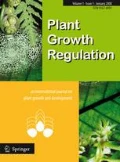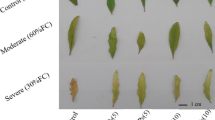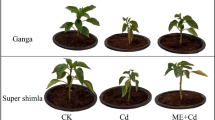Abstract
Cucumber (Cucumis satvus L.) seeds were imbibed in distilled water (control) and 10 mg l−1 triadimefon (TDM) for 10 h and then grown in a plant growth chamber with a light/dark temperature of 28/20 °C and a photoperiod of 14 h with a light intensity of 60 µmol m−2 s−1. 14-day-old seedlings were exposed to chilling stress with a light/dark temperature of 6/3 °C for 4 d. TDM improved the growth rate of cucumber seedling subjected to chilling stress and increased photosynthetic pigments contents and relative water content compared with the control at the end of chilling stress. Chilling stress decreased protein content and the activities of SOD, CAT and POD, but it increased proline, H2O2 and MDA accumulation, and relative electrical conductivity. TDM ameliorated the injury caused by chilling stress by preventing decreases in protein content and the activities of SOD, CAT and POD and by inhibiting increases in proline, H2O2 and MDA contents, and relative electrical conductivity, which suggested that TDM ameliorated the negative effect of chilling stress.
Similar content being viewed by others
References
Aebi H. 1984. Catalase in vitro. Meth. Enzymeol. 105: 121–126.
Anderson M.D., Prasad T.K. and Stewart C.R. 1995. Changes in isozyme profiles of catalase, peroxidase, and glutathione reductase during acclimation to chilling in mesocotyls of maize seedlings. Plant Physiol. 109: 1247–1257.
Arnon D.I. 1949. Copper enzymes in isolated chloroplasts polyphenoloxidase in Beta vulgaris. Plant Physiol. 24: 1–15.
Asare-Boamah N.K. and Fletcher R.A. 1986a. Protection of bean seedlings against heat and chilling injury by triadimefon. Physiol. Plant 67: 353–358.
Asare-Boamah N.K., Hofstra G., Fletcher R.A. and Dumbroff E.B. 1986b. Triadimefon protects bean plants from water stress through its effects on abscisic acid. Plant Cell Physiol. 27: 383–390.
Bradford M.M. 1976. A rapid and sensitive method for quantification of microgram quantities of protein utilizing the principle of protein dye binding. Anal. Biochem. 72: 248–254.
Buchenauer H. and Rohner E. 1981. Effect of triadimefon and triadimenol on various plant species as well as on gibberellin content and sterol metabolism in shoots of barley seedlings. Pestic. Biochem. Physiol. 15: 58–70.
Chaitanya K.S.K. and Naithani S.C. 1994. Role of superoxide, lipid peroxidation and superoxide dismutase in membrane perturbation during loss of viability in seeds of Shorea robusta Gaertn.f. New Phytol. 126: 623–627.
Chen J.Z., Xu C.X. and Liang L.F. 1999. Effect of low temperature on protein and proline in banana (Musa spp.) leaves. J. South China Agric. Univ. 20: 54–58.
Chen S.Y. 1991. Injury of membrane lipid peroxidation to plant cell. Plant Physiol. Commun. 27: 84–90.
Dai J.P., Shen Z.Y. and Jian L.C. 1991. The effects of cold acclimation on several enzyme activities in cucumber seedlings. Acta Bot. Sin. 33: 627–632.
Dhindsa R.S., Dhindsa P.P. and Thorpe T.A. 1981. Leaf senescence: Correlated with increased levels of membrane permeability and lipid peroxidation, and decreased levels of superoxide dismutase and catalase. J. Exp. Bot. 32: 93–101.
Fletcher R.A. and Hofstra G. 1985. Triadimefon a plant multiprotectant. Plant Cell Physiol. 26: 775–780.
Fletcher R.A. and Hofstra G. 1988. Triazoles as potential plant protectants. In: Berg D. and Plempel M. (eds), Sterol Biosynthesis Inhibitors. Ellis Horwood, Cambridge, pp. 321–331.
Fletcher R.A. and Nath V. 1984. Triadimefon reduces transpiration and increases yield in water stressed plants. Physiol. Plant 62: 422–426.
Fletcher R.A., Hofstra G.H. and Gao J.G. 1986. Comparative fungitoxic and plant growth regulating properties of triazole derivatives. Plant Cell Physiol. 27: 367–371.
Flores A., Grau A., Laurich F. and Dorffling K. 1988. Effects of new terpenoid anologues of abscisci acid on chilling and freezing resistances. J. Plant Physiol. 132: 362–363.
Foyer C.H., Descourvieres P. and Kunert K.J. 1994. Protection against oxygen radicals: An important defense mechanism studied in transgenic plants. Plant Cell Environ. 17: 507–523.
Gong M., Liu Y.L. and Zhu P.R. 1989. Changes of proteins and free amino acids in leaves of rice seedlings during chilling stress. Plant Physiol. Commun. 26: 18–22.
Guo Z.F., Lu S.Y. and Li M.Q. 1997. Promotive effect of triadimefon on drought resistance of rice seedlings. Acta Bot. Sin. 39: 541–545.
Guy C.L. 1990. Cold acclimation and freezing stress tolerance. Role of protein metabolism. Annu. Rev. Plant Physiol. Plant Mol. Biol. 41: 187–223.
Huang F.L., Dai L.Y. and Luo K. 2000. Mechanism studies on pharmaceutical induction for resistance to cold of rice seedlings. Acta Agron. Sin. 26: 92–97.
Jian L.C. 1992. Advances of the studies on the mechanism of plant cold hardiness. Chin. Bull. Bot. 9: 17–22.
Kar P.K. and Choudhuri M.A. 1987. Possible mechanisms of lightinduced chlorophyll eradication in senescencing leaves of hydrila veticillata. Physiol. Plant 70: 729–734.
Li B.L. and Mei H.S. 1989. Relationship between oat leaf senescence and activated oxygen metabolism. Acta Phytophysiol. Sin. 15: 6–12.
Li L. and Staden J.V. 1998. Effects of plant growth regulators on drought resistance of two maize cultivars. S. Afr. J. Bot. 64: 116–120.
Liang Y. and Wang S.G. 2001. The protective function of Ca2+ on the membrane of rice seedling under low temperature stress. Acta Agron. Sin. 27: 59–63.
Mukherjee S.P. and Choudhuri M.A. 1983. Implication of water stress-induced changes in the levels of endogenous ascorbic acid and hydrogen peroxidation in Vigna seedlings. Physiol. Plant 58: 166–170.
Muthukumarasamy M. and Panneerselvam R. 1997. Amelioration of NaCl stress by triadimefon in peanut seedlings. Plant Growth Regul. 22: 157–162.
Muthukumarasamy M., Duttagupta S. and Panneerselvam R. 2000. Enhancement of peroxidase, polyphenol oxidase and superoxide dismutase activities by triadimefon in NaCl stressed Raphanus sativus L. Biol. Plant 43: 317–320.
Nishida I. and Murata N. 1996. Chilling sensitivity in plants and cyanobacteria: the crucial contribution of membrane lipids. Annu. rev. Plant Physiol. Plant Mol. Biol. 47: 541–568.
Pell E.J. and Dann M.S. 1991. Multiple stress and plant senescence. In: Mooney H.A., Winner W.E. and Pell E.J. (eds), Integrated Response of Plants to Stress. Academic Press, San Diego, pp. 189–284.
Pinhero R.G. and Fletcher R.A. 1994. Paclobutrazol and ancymidol protect corn seedlings from higher and low temperature stresses. Plant Growth Regul. 15: 47–53.
Rademacher W. 1992. Biochemical effects of plant growth retardants. In: Gausman H.W. (ed.), Plant Biochemical Regulators. Marcel Dekker, New York, pp. 169–200.
Shen M., Wang M.X. and Huang M.R. 1997. Advances in research on chilling-resistance mechanisms of plants. Chin. Bull. Bot. 14: 1–8.
Simon E.W. 1974. Phospholipids and plant membrane permeability. New Phytol. 73: 377–420.
Tang Z.C. 1984. Accumulation of proline in stressed plants and its possible significance. Plant Physiol. Commun.: 15–21.
Upadhyaya A., Davis T.D., Walser R.H., Galbraith A.B. and Sankhla N. 1989. Uniconazole-induced alleviation of low-temperature damage in relation to antioxidant activity. Hortscience 24: 955–957.
Upadhyaya A., Sankhla D., Davis T.D., Sankhla N. and Smith B.N. 1985. Effect of paclobutrazol on the activities of some enzymes of activated oxygen metabolism and lipid peroxidation in senescing soybean leaves. J. Plant Physiol. 121: 453–461.
Wang S.G. and Liang Y. 1995. Protection of 6-Benzyladenine on cell membrane system of rice seedlings under chilling stress. J. Rice Sci. 9: 223–229.
Zeng S.X., Wang Y.R. and Liu H.X. 1991. Some enzymatic reactions related to chlorophyll degradation in cucumber cotyledons under chilling in the light. Acta Phytophysiol. Sin. 17: 177–182.
Zhou W.J. and Leul M. 1998. Uniconazole-induced alleviation of freezing injury in relation to changes in hormonal balance, enzyme activities and lipid peroxiadation in winter rape. Plant Growth Regul. 26: 41–47.
Zhu G.L., Deng X.W. and Zuo W.N. 1983. Determination of free proline in plants. Plant Physiol. Commun.: 35–37.
Zhu G.R., Zhong H.W. and Zhang A.Q. 1990. Plant Physiology Experiment. Peking University Press, Beijing, pp. 242-245.
Author information
Authors and Affiliations
Rights and permissions
About this article
Cite this article
Feng, Z., Guo, A. & Feng, Z. Amelioration of chilling stress by triadimefon in cucumber seedlings. Plant Growth Regulation 39, 277–283 (2003). https://doi.org/10.1023/A:1022881628305
Issue Date:
DOI: https://doi.org/10.1023/A:1022881628305




